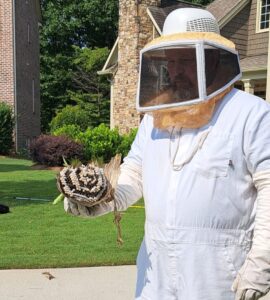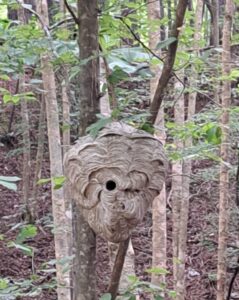Bald-faced Hornets
It’s a hornet…it’s a bee…no, it’s actually a wasp! That’s right, the name Bald-faced Hornet is actually a misnomer. The common name bald-faced or white-faced hornet is given due to the white markings found on the head and abdomen tip. The face itself is mostly white with dark eyes. They have large antennae and wings that fold lengthwise when they are resting. Coloration, size, and shape can sometimes cause misidentification as bees, however, that too is untrue. 
The home of this social insect is easily identified in the southeastern United States this time of year because of its large paper nest. As big as a basketball and sometimes 3 feet tall, the sight of a bald-faced condo in your backyard can be a terrifying discovery. And with good reason.
Even though the Bald-faced Hornet is found throughout all of North America, they are most common in the southeastern part of the United States, including unsuspecting Canton backyards.
As far as diet, they like to eat soft-bodied insects such as caterpillars and aphids. The ‘not’ hornets also need carbs in the form of nectar and protein such as flowering plants as a part of their ideal food sources. Interestingly, they like meat products similar to the diet of a yellowjacket.
The huge nests built by the Bald-faced hornets are inhabited by large groups of insects including a queen, drones, and workers. The different jobs are uniquely divided in the colony. The queen, of course, lays hundreds of eggs, while the drones are all male and function to fertilize the queen. Workers build, maintain, and feed the nest.
So what about this massive nest?
The process of nest building begins in the spring with the queen collecting cellulose (wood) fibers to make the future nest. She chooses a variety of locations such as the eaves of a building or a tree branch. The collected fibers are mixed with saliva and construction starts with layers of cells resembling a honeybee comb. Usually, there are 3 or 4 tiers of these combs inside a thicker, paper mache-type outer shell. The bald-faced hornets come and go through an opening located at the bottom of the football or basketball-shaped nest. Similar to most bees, wasps, and hornets, the nests are not reused and are abandoned at the end of each season. If you happen to enjoy the idea of a fresh start, then the habits of the bald-faced may appeal to your wanderlust.
Even though the nest is not used again, there is a member of the colony who does survive the winter. The queen is the lone survivor of a colony and emerges in April or May of the year to begin her construction of a small nest. There she will begin to raise her sterile daughters to become the season’s workers. They will then have the duty of finishing the completion of the nest, finding food sources, and even caring for the offspring which will come later. The queen’s work is now done, and she herself only lays more eggs at this point. It is a strange turn of events, but the queen has stored sperm and fertilizes most eggs as she lays them. There are some eggs intentionally left out of the sperm dispersal. Unfertilized eggs have only half the number of genes as the queen and workers and develop into male drones.
UMMM…there’s so much to say here ladies, however, I won’t. Males are obviously useful in their own right.
Okay, back to Hornets. In maturity, the colony usually has 200-400 (although up to 700 have been found) insects. That’s a big family.
Now onward to the real question: what about the stinging thing?
All social wasps sting and are known to be quite painful. Unlike the honeybee, they do not leave their stinger in the skin. The reason they do not is that their stingers are smooth. But here’s the negative consequence of that scenario: they can each sting multiple times, leaving the venomous fluid under the skin of the victim. Ouch.
Why do they sting? As is usual in nature, they sting to protect their home and themselves. When a colony is disturbed, intentionally or not, this is the most likely time for stings to occur. If you watch a nest, you will see hornets guarding the opening. They are protecting and will definitely attack if someone gets too close.
Interesting to observe from a distance, these insects are definitely not known for their friendly demeanor. Stay away and stay safe!
If you are concerned with insects of the stinging kind or any other pesky visitors, give us a call at Canton Termite and Pest Control!
Let us help you live pest free.
770-479-1598
